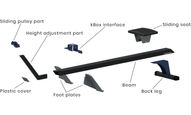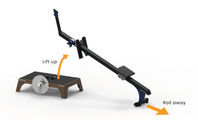Exxentric
Strength Row
Investigating the usefulness of a flywheel-based add-on product for seated strength row
2018 | 20 weeks
View the full Thesis report in the PDF

Task
Flywheel resistance training have in recent years become increasingly popular among athletes and
coaches globally due to the advantages it provides over traditional strength training with weights.
Exxentric was looking to further increase the number of exercises that could be performed with their devices. Primarily, seated strength row exercises had been identified as a gap and there was a desire to develop an add-on product to extend their kBox4 device platform. Thus, the main objective for this project was to investigate the usefulness of such a product in order to see if it was possible to strengthen Exxentric's business with such a product.




Approach
The project was carried out through a User-Centered Design approach which started with user studies to generate insights and to create and understanding of the context. This later made it possible to specify product requirements based on user needs which was considered when solutions were constructed or designed. After which the solutions could be evaluated together with intended users and against the established user needs. From the results of the evaluations, further iterations occurred until results of the solutions were satisfactory,

The users
The main objective for Exxentric, with an add-on product for seated strength row was not to widen the target audience but to increase average order value. By analysing and interviewing the customers in Exxentric’s three segments: Performance sports, Health & fitness and Rehabilitation, through discussions with Exxentric Management- and Sales and Marketing team, three different personas could be developed. The project therefore also had to take into consideration which of the existing user groups would be best suited for such a product.

User studies
The research consisted of multiple contextual interviews and observational sessions. Key behaviours observed, and opinions expressed during interviews were written on post it
notes and clustered into groups in order to make conclusions and gain insights. They were rearranged for three iterations with the first round focusing on gaining insights regarding different features of existing rowers. The second round focused on actions performed during the use and potential risks associated with the exercise and the possible addition of a flywheel resistance. Finally, the third round was mapped linearly with post-its sorted chronologically and focused on gaining insights of points to consider for an add-on product aimed at seated strength rows.




Insights
After analysing the research it became clear that a product of this kind would mostly benefit users from the performance sports segment. Having a defined user segment was important as a product which aims to fulfil the needs of a too broad segment would not be optimized for any user’s needs as different groups generally have different prerequisites.The target group generally have extensive training experience and often train together with a coach or trainer which are good prerequisites for using a flywheel-based rower add-on. With the defined user, input of relevance from the interviews and observations for the chosen segment was clustered together once more into main themes to consider and evaluate against during the user tests of the construction phase.

Prototyping & Testing
The ideation and prototyping process was carried out in an iterative way with testing and refinement of changes being evaluated continuously. User tests occurred frequently to generate unbiased user input to changes being made. Testers included athletes and experienced users of the kBox4.
Design & Construction
Applying design guidelines was done in parallel with the construction work to make sure that design and function would be integrated together. During the construction process, when the main functions and features were set, a range of structural variations of different shapes was created. The shape of the foot plates, seat, leg and beam was evaluated against the Design Platform to investigate what best represented Exxentric’s brand.
Analysis
The business case with the add-on was to increase average order value and after sales business according to the PID. As such, the add-on is intended to be sold either together with minimum one kBox model or to customers who previously purchased a kBox. If it should be possible to use it with any kBox model it should, being an add-on product, be sold for less than the lowest priced kBox model.
Since the add-on allows for additional exercises being performed other than seated strength rows, it could be considered to provide more value for money compared to if it only was possible to perform one exercise. However, allowing for several horizontal exercises, it could be competing for sales with the kPulley, the device optimised for horizontal exercises.
Increasing order value does not only have to be whenever someone orders a kBox, it could be when someone makes a larger purchase of several different devices. In which case, if customers choose to purchase a kBox with the add-on over buying a kBox and a kPulley, the average order value would decrease. It could also be the case that customers prefer to purchase a kPulley over the add-on, if the price difference between the two is too low and perform seated strength rows with the kPulley seated on a bench while getting the complete device optimised for horizontal movements.
The project was carried out under limitations that the add-on product should not require any changes being made to the current design of the kBox4. This caused several trade-offs to be made throughout the project, impacting the usefulness of the add-on. Considering the trade-offs, if a perfect row experience is desired it might be necessary to investigate the possibility to develop a standalone product which can be optimized for seated strength row without the pre-existing delimitations that comes with developing an add-on product.































